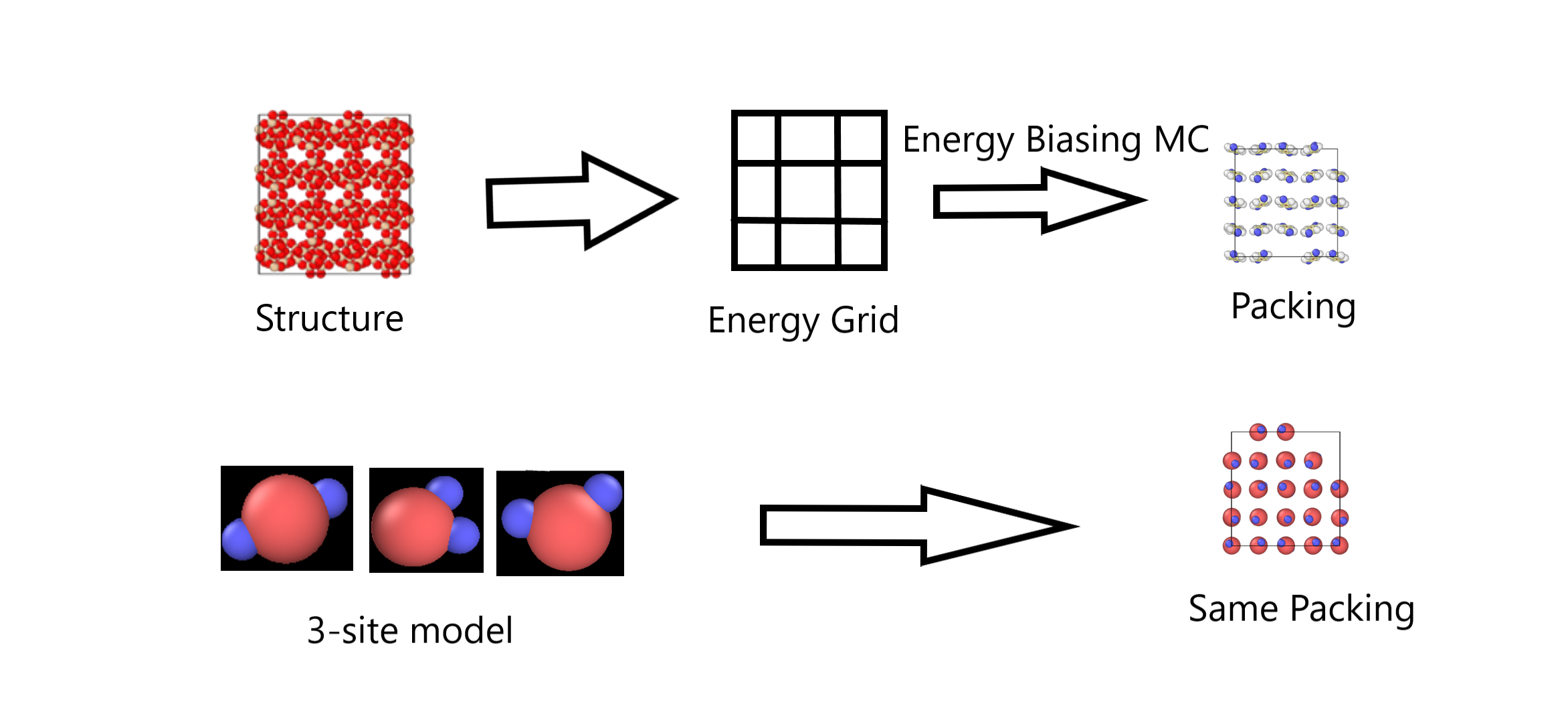p-Xylene is one of the most important chemicals in the world. However, separation of p-xylene from the other xylene isomers is difficult because the isomers have similar physical properties, such as boiling points.
1 Previous studies have shown that porous materials such as zeolites and metal-organic frameworks (MOFs) can be useful for xylene separations,
2â4 and there are several proposed mechanisms for adsorption separation of xylenes. Torres-Knoop et al.
3,5 proposed the âcommensurate stackingâ mechanism in 1D channels, in which para-selectivity arises because p-xylene can use the space in the framework more effectively than the other isomers.
Here we present a computational screening study of the p-xylene selectivities using grand canonical Monte Carlo (GCMC) simulations of 1D channel structures from the ToBaCCo MOF database by Colon et al.6 To overcome the difficulties in inserting xylene molecules in tight-fitting pores, we used the Energy-Biasing Monte Carlo (EBMC) scheme7 to place the center of the aromatic ring and combined EBMC with orientational biasing of the rigid xylene molecules. We found that this combined biasing move is highly effective when dealing with insertions at saturation loading, when the packing is very tight, and the molecules are localized at specific locations.
Using this method, we were able to identify structures within the ToBaCCo database with high para-selectivity. Some of them present different packing patterns than what Torres-Knoop et al. reported,3,5 and we conclude that face-to-face stacking is not the only way to achieve high para-selectivity. We observe mechanisms including parallel slit interaction, perpendicular stacking and steric hindrance.
We also propose a more coarse-grained model that can be used to significantly speed up the screening process. In the coarse-grained model, the aromatic ring is represented by a single âlargeâ Lennard-Jones site with 2 attached methyl sites, creating a three-site model for the xylene isomers. We show that this simple model can mimic the behavior of the more detailed model4 in GCMC simulations of adsorption, in particular for the selectivity and molecular packing in the 1D channels.
References:
(1) Sholl, D. S.; Lively, R. P. Seven Chemical Separations to Change the World. Nature News 2016, 532 (7600), 435. https://doi.org/10.1038/532435a.
(2) Gee, J. A.; Zhang, K.; Bhattacharyya, S.; Bentley, J.; Rungta, M.; Abichandani, J. S.; Sholl, D. S.; Nair, S. Computational Identification and Experimental Evaluation of MetalâOrganic Frameworks for Xylene Enrichment. J. Phys. Chem. C 2016, 120 (22), 12075â12082. https://doi.org/10.1021/acs.jpcc.6b03349.
(3) TorresâKnoop, A.; Krishna, R.; Dubbeldam, D. Separating Xylene Isomers by Commensurate Stacking of P-Xylene within Channels of MAF-X8. Angewandte Chemie International Edition 2014, 53 (30), 7774â7778. https://doi.org/10.1002/anie.201402894.
(4) Castillo, J. M.; Vlugt, T. J. H.; Calero, S. Molecular Simulation Study on the Separation of Xylene Isomers in MIL-47 MetalâOrganic Frameworks. J. Phys. Chem. C 2009, 113 (49), 20869â20874. https://doi.org/10.1021/jp908247w.
(5) TorresâKnoop, A.; Balestra, S. R. G.; Krishna, R.; Calero, S.; Dubbeldam, D. Entropic Separations of Mixtures of Aromatics by Selective Face-to-Face Molecular Stacking in One-Dimensional Channels of MetalâOrganic Frameworks and Zeolites. ChemPhysChem 2015, 16 (3), 532â535. https://doi.org/10.1002/cphc.201402819.
(6) Colón, Y. J.; Gómez-Gualdrón, D. A.; Snurr, R. Q. Topologically Guided, Automated Construction of MetalâOrganic Frameworks and Their Evaluation for Energy-Related Applications. Crystal Growth & Design 2017, 17 (11), 5801â5810. https://doi.org/10.1021/acs.cgd.7b00848.
(7) Snurr, R. Q.; Bell, A. T.; Theodorou, D. N. Prediction of Adsorption of Aromatic Hydrocarbons in Silicalite from Grand Canonical Monte Carlo Simulations with Biased Insertions. J. Phys. Chem. 1993, 97 (51), 13742â13752. https://doi.org/10.1021/j100153a051.


